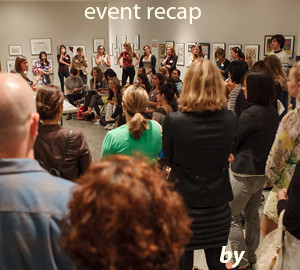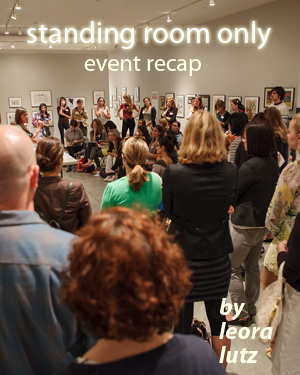Event Recap: Standing Room Only
Success as we know it? It has so many definitions and variables, it’s difficult to know where to begin.
Bay Area Emerging Museum Professionals and Emerging Arts Professionals / San Francisco Bay Area thought one place to start would be an engaging conversation among those who are defining — and redefining — success in the arts regularly. On August 14, The Cartoon Art Museum welcomed the groups and a lineup of experts in the field to crack open the ideas surrounding the nebulous “success.”
Constantly Felt
The view of success can change each time a new event happens, each time new feedback is given, each time an idea is scrapped before it even makes its way to the stage. On the other hand, the view of success also changes once that email comes in with a life-changing sentiment, a production is able to continue to bring in guest artists because of record-breaking ticket sales, or the program that was a huge risk turned out to be the most popular Friday night since DIY became a household term.
As success is a measurable aspect of the art business that supports the future of museum and performing arts, and as we are still in a time of talking about the precarious “economic climate,” the topic of success will invariably be a never-ending discussion.
With all of its myriad definitions, success is contingent upon measurable results but, more important, it is dependent on fulfilling the mission and artistic vision of the organization.
Success becomes a manner of ownership, not just opinion, as each individual curator, performer, museum-goer, educator, administrator (and so on) only furthers the complexity of what success means to them and to the organizations they work for or support in other ways. Success is something shared and felt. It is something that vibrates and generates a magnetic energy.
Putting it that way highlights how vital it is for an organization to remain successful. Some key points throughout the discussion to keep an organization on track:
- Trust whomever you are working with has something to offer.
- Set your visions and voices at a high concept denominator — the lowest common denominator is not a worthy or engaging standard.
- Build credibility so you can “trade” it up later.
- Be true to your mission (and rewrite that mission whenever necessary).
If at First
Failure seems to be a buzzword that has been, well, buzzing around lately. It’s all I’ve heard since I arrived a year ago to the Bay Area. There seems to be an acceptance of failure in ways that almost mimic apology. It’s as if people are reveling in the failure/success paradigm whose benefit is perhaps a form of acceptance of the unattained. Is this counter-productive?
Gregory Stock, museum educator at Fine Arts Museums of San Francisco, reminds the audience that the inherent benefit of failure is to rise to the surface. I would posit that being in a place of discomfort, and maybe even failure, are places where the real risk can take place, where fresh ideas can happen.
Annie Phillips, public relations assistant at the San Francisco Symphony and manager of Magik*Magik Orchestra, noted that failure is an opportunity to reassess and do things better the next time.
But as ODC‘s director of institutional giving Brian Wiedenmeier notes, the opposite sometimes happens: “focused on success to the exclusion of failure.” At what cost? “Everybody has sucked every now and then and we just don’t talk about it,” Wiedenmeier quips.
Rob Ready, marketing manager at ODC and co-founder of PianoFight, explained that failure is embarrassing but also humbling to talk about because it gets people to value what they do and to be more focused on putting their money where it matters.
Bottoms Up!
Without a doubt, the ubiquitous bottom line is a point of constant concern.
“The art world is afraid of money and this is a bad thing,” claims Stock and, in many ways, I would have to agree. It seems to be an unspoken need that is supposedly overshadowed by altruism. And so the success plot thickens even more. To use the proverbial bottom line again, art institutions and artists need program funding and monetary compensation to survive. In many ways, survival and longevity are forms of success.
Measuring this success requires malleability for new media outlets and maintaining the more tried and true forms of communication also. Jenna Glass, associate director of marketing at ODC, had some sound tips.
- Have a dynamic and interactive web presence that you monitor and update regularly.
- Involve yourself in social media in ways that are generative to the current programs.
- Be nimble and try new strategies.
- Know your audience (we say this all the time!) and develop niche strategies within the larger organization to build new audiences.
With that, sometimes the niche will grow into the new mission, or be a supplemental program that can help fund the other important projects. I would add, as learned from a previous blog post about place-making: talk to people, survey and chat with your audience, share your ideas with others so you can build a critical mass of ideas. Imagine the impact if several institutions were propelling similar ideas at the same time!
Meaningful Experiences
Timothy Anglin Burgard, Ednah Root Curator in Charge of American Art for the Fine Arts Museums of San Francisco, shared an inspiring, passionate, and articulate speech challenging the audience to take a more political position and to confront mediocrity with their practice.
Museums owe it to the community to fuel ideas that generate new, valuable thought and change in the community. As so many of us are “preaching to the converted,” as Burgard stated, it is important to look beyond our comfort zones and to be in opposition to what we are used to. I would say that would apply well to anyone: as visitors to museums and each other’s projects to discussing programming ideas for future exhibitions and performances to sitting in board meetings.
Meaningful experiences are paramount to success, and everyone would benefit from a greater understanding of how to define ideas of what is meaningful to an institution and in their own personal practice.
To quote Glass earlier in the panel: “What is the story I need to tell?” Again, success is circling back to what matters, and the meaning. Or as Phillips stated, “[It’s] what gets across the footlights.”
Holly Turner began the panel with an exercise:
As a ________ I am ________ . When I work in ________ I need to have ________ and ________.
As self-affirming as it may seem, it is perhaps not something that we plainly say on a regular basis. And perhaps perhaps even more elementary, it can be a way of understanding others if put in the form of a question.
Now more than ever as artists and arts workers are being asked to wear multiple hats, new meanings for success need to be created. What seems to be at the crux of success is “the push”: push the programming and ultimately push boundaries aside and push expectations. From the grandiose to humble, success has the potential for greatness.
About Leora Lutz
Leora Lutz (http://www.leoralutz.com/index.html) is an exhibiting, interdisciplinary artist with a professional history as a writer, gallerist and art administrator. All aspects of her practice grab onto historical context, alters it, and re-presents it as a way to shift previous understanding into flux. Her work has shown at galleries, institutions and museums, including MOCA LA, Palm Springs Museum of Art, The Wattis Institute for Contemporary Art, Riverside Art Museum and the Henry Project Space in Seattle. Her art and professional bibliography includes numerous critiques and profiles from The Los Angeles Times, NBC news, White Hot Magazine and LA Weekly to name a few.






Leave a Reply
Want to join the discussion?Feel free to contribute!